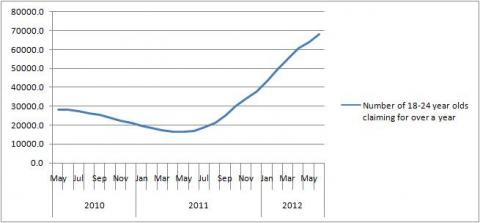Have long-term jobless youths tripled in one year?
"there was another rise in the long-term jobless figures, with those out of work for more than two years up by 18,000 to 441,000 — the highest since 1997"
The Sun, 19 July 2012
This week heralded the Office for National Statistics' (ONS) monthly release of UK Labour Market Statistics and one prolific tweeter joined the general stampede of people rushing to comment on the different figures the bulletin revealed.
Sifting through the string of Mr Belardinelli's offerings on the ONS release, Full Fact noticed a striking figure: the number of young people claiming Job Seekers Allowance for over a year has tripled since last year, meaning this is the highest level since April 1997.
Sixteen minutes later, Mr Belardinelli corrected part of this first tweet, replacing "April 1997" with "August 1997". But is this the only adjustment needed?
Analysis
Full Fact is no stranger to claims about long-term unemployment, and exactly a month ago we investigated the Sun's claim that long-term youth unemployment had 'soared' by 900 per cent since 1997 - a claim that doesn't really give the full picture.
Yesterday's tweet used the same measure - the number of 18-24 year-olds claiming Jobseeker's Allowance for over 12 months. The Labour Market Statistics release provides the necessary data.
The latest bulletin confirms that, in June 2011, the number of 18-24 year olds claiming JSA for over a year was 16,800. In June 2012 (the latest data), the number of claimants increased dramatically to 68,200.
Looking back over the years, the last time the number of 18-24 year old claiming JSA for over a year was higher than 68,200 was indeed in August 1997, so this much is accurate.
However, while the leap in the number of 18-24 year olds claiming JSA for over a year is indeed a large one, it has not tripled. 68,200 18-24 year olds is easily more than quadruple 16,800 18-24 year olds. This is a common mistake of translating 300 per cent increases as 'triple'.
Mr Belardinelli's later retweet of Labour List's (correct) claim that "the number of young people on the dole for 12 months or more is up 306%", supports the idea that this mistake is not a deliberate fiddling or indeed a fundamental misunderstanding of the figures.
To give some perspective on this increase anyway, the graph below shows the level of 18-24 year olds claiming JSA for over a year since the the Coalition took over in May 2010.

As we can see, the number has been increasing dramatically since the spring of 2011, although the reasons behind this aren't what they seem at first glance.
Which measure to use?
However, as the Sun's report this morning makes clear, this is not the only way of measuring long-term unemployment. The Sun used the measure of those unemployed for over two years, which is obviously quite different to the number claiming Jobseeker's Allowance for over one year. This explains the disparities between the figures.
The root of the problem is that there is not only one way of measuring long-term unemployment, whether among young people or concerning everyone.
While newspapers and tweeters can take their pick between using the claimant count and the unemployment figures, they can also choose what duration they care to point out. In Mr Belardinelli's case, it was 'over one year'. In the Sun's case, it was 'over two years'. Back in April outlets were content to report the rates 'over six months'.
The measure you choose to report actually changes the picture of unemployment considerably. Here are just some of the common options available when reporting unemployment or dole counts among young people:

Compared to a year ago, the picture certainly indicates that the numbers of young people out of work or claiming are certainly up, however the increase is very different depending on the duration chosen as a definition of 'long-term unemployed'.
Conclusion
Taken on Mr Belardinelli's terms, it is correct to say the number of young people claiming Jobseeker's Allowance for more than a year has increased, although it has quadrupled, not tripled. If anything, he understated his case.
However, this is not the only way to measure long-term youth unemployement. As evidenced by the Sun's reporting today and the Express and Independent's coverage earlier this year, the percentage increase in long-term jobless youths can differ greatly according to which definition of "long-term unemployed" you pick.